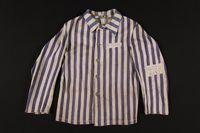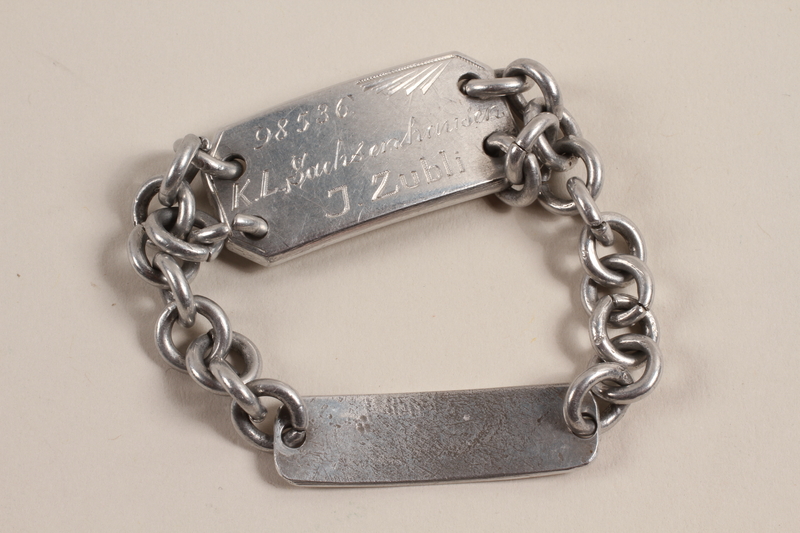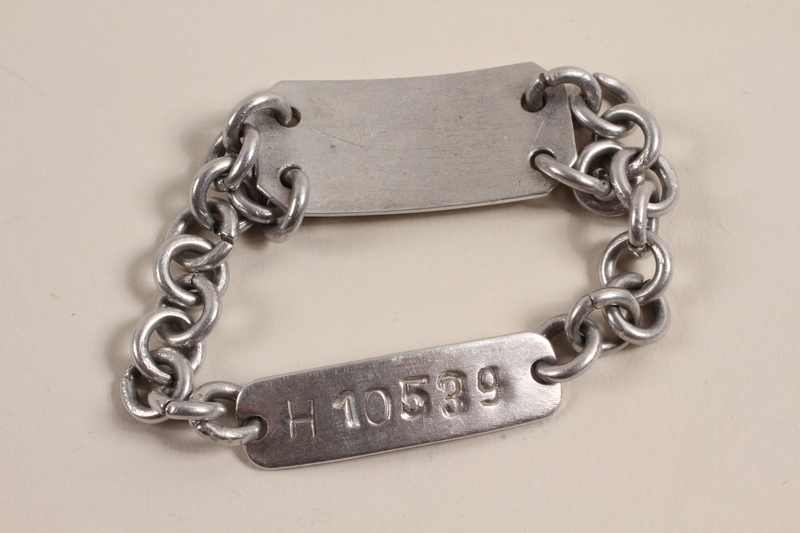Overview
- Brief Narrative
- Prisoner identification bracelet worn by Dr. Julius de Clercq Zubli in Sachenhausen concentration camp in Germany from September 1944-April 1945. Zubli was a non-Jewish Dutch physician in Amsterdam who aided Jews and the Dutch resistance in German-occupied Netherlands, 1940-1945. Zubli issued papers to Jews falsely stating that they had a contagious disease which delayed their deportation. He helped Jews go into hiding and delivered false food ration cards for the underground. In May 1944, Julius was arrested while caring for resistance leader, Gerrit van der Veen, shot during an armed raid of German Security headquarters. On July 6, Zubli was sent to Herzogenbusch (Vught) transit camp in Holland, then in September, to Sachsenhausen. He was liberated in April 1945 and, after the war ended in May, returned to Amsterdam and resumed his medical practice.
- Date
-
received:
1944 September-1945 April
- Geography
-
use:
Sachsenhausen (Concentration camp);
Oranienburg (Germany)
- Credit Line
- United States Holocaust Memorial Museum Collection, Gift of the Estate of Julius de Clerq Zubli
- Contributor
-
Subject:
Julius K. I. de Clercq Zubli
- Biography
-
Julius Karel Isaac de Clercq Zubli was born on June 5, 1899. He was a physician with a medical practice in Amsterdam, Holland, where he lived with his wife, daughters Julda and Pom and oldest son "Co." The Netherlands was occupied by Germany in May 1940. Dr. Zubli was recognized by the Red Cross for his service during the mobilization and brief war.
By spring 1941, the Germans were enacting policies to segregate Jews from the general Dutch population. Dr. Zubli was not Jewish and he continued to treat his Jewish patients in defiance of orders issued by the German occupation authorities. As a physician, he had a permit to be out after curfew, and he provided medical and other services to the Dutch resistance. In the summer of 1942, the Germans began deportations of Jews to concentration camps. Dr. Zubli issued Jews false medical documents claiming that they were suffering from contagious diseases, which postponed their deportation. A Jewish family, the Reiner’s, lived above Zubli’s medical practice. The Gestapo came to arrest the family, but Dr. Zubli told them the son had scarlet fever and needed to be quarantined for six weeks. The Gestapo left and Dr. Zubli helped the family go into hiding. Dr. Zubli also supplied hidden Jews with false food ration stamps that he received from a local resistance group. The Germans, suspicious of Zubli’s actions, searched his home multiple times.
On May 3, 1944, Zubli treated the resistance fighter Gerrit van der Veen, who was shot during an armed raid on German Security Police headquarters in Amsterdam. On May 12, while Zubli was visiting van der Veen, both were arrested by the Gestapo. Zubli’s wife hurried to the German police headquarters to retrieve his patient book. The book contained code names for members of the Dutch underground and possible escape routes. His wife told them the replacement doctor needed it to continue treating patients and the police returned it. Van der Veen was executed with six others, on June 10. On July 6, Zubli was sent to Herzogenbusch (Vught) transit camp in Holland and assigned prisoner number 98536. In September, he was sent to Sachsenhausen concentration camp in Germany. Sachsenhausen was liberated by the 47th Soviet Army on April 22th, 1945. After the war ended in May1945, Zubli was cleared by the US Army to return to Amsterdam where he resumed his medical practice. Dr. Zubli, age 68, died in 1967 in Amsterdam. On March 18, 2001, he was recognized by Yad Vashem as Righteous Among Nations.
Physical Details
- Language
- German
- Classification
-
Identifying Artifacts
- Category
-
Labels
- Object Type
-
Identification bracelets (lcsh)
- Physical Description
- Silver colored metal chain link identification bracelet with 2 engraved plates. One rectangular plate has angled corners with 4 punched circular holes and stamped German text, numbers, and a sunburst. The smaller rectangular plate has rounded corners with 2 circular holes on the left and right edges and stamped German text and numbers. Two links of circular chain are attached to the 4 holes of the rectangular plate and joined to a chain link connected to the 2 holes on the other plate.
- Dimensions
- overall: Height: 0.750 inches (1.905 cm) | Width: 2.000 inches (5.08 cm) | Depth: 2.500 inches (6.35 cm)
- Materials
- overall : metal
- Inscription
- rectangular plate, cursive and printed, engraved : 98536 / K.L. Sachsenhausen / J. Zubli
oval plate, engraved : H10539
Rights & Restrictions
- Conditions on Access
- No restrictions on access
- Conditions on Use
- No restrictions on use
Keywords & Subjects
- Topical Term
- Concentration camp inmates--Germany--Biography. Holocaust, Jewish (1939-1945)--Netherlands--Personal narratives, Dutch. Physicians--Netherlands--Biography. Righteous Gentiles in the Holocaust--Netherlands--Biography. World War, 1939-1945--Jews--Rescue--Netherlands--Personal narratives, Dutch. World War, 1939-1945--Underground movements--Netherlands--Personal narratives.
- Geographic Name
- Netherlands--History--German occupation, 1940-1945.
Administrative Notes
- Legal Status
- Permanent Collection
- Provenance
- The identification bracelet was donated to the United States Holocaust Memorial Museum in 2004 by Dan de Clerq Zubli on behalf of the Estate of Dr. Julius de Clercq Zubli.
- Funding Note
- The cataloging of this artifact has been supported by a grant from the Conference on Jewish Material Claims Against Germany.
- Record last modified:
- 2024-02-26 12:04:14
- This page:
- https://collections.ushmm.org/search/catalog/irn522415
Download & Licensing
In-Person Research
- By Appointment
- Request 21 Days in Advance of Visit
- Plan a Research Visit
- Request to See This Object
Contact Us
Also in Julius de Clercq Zubli collection
The collection consists of a concentration camp uniform jacket and a prisoner identification bracelet relating to the experiences of Dr. Julius de Clercq Zubli as an inmate of Sachsenhausen concentration camp in Germany following his deportation from the Netherlands for resistance activities during the Holocaust.
Date: 1944 July 06-1945 April

Concentration camp uniform jacket worn by a non-Jewish doctor/resistance member
Object
Striped concentration camp uniform jacket worn by Dr. Julius de Clercq Zubli in Sachenhausen concentration camp in Germany from September 1944-April 1945. Zubli was a non-Jewish Dutch physician in Amsterdam who aided Jews and the Dutch resistance in German-occupied Netherlands, 1940-1945. Zubli issued papers to Jews falsely stating that they had a contagious disease which delayed their deportation. He helped Jews go into hiding and delivered false food ration cards for the underground. In May 1944, Julius was arrested while caring for resistance leader, Gerrit van der Veen, shot during an armed raid of German Security headquarters. On July 6, Zubli was sent to Herzogenbusch (Vught) transit camp in Holland, then in September, to Sachsenhausen. He was liberated in April 1945 and, after the war ended in May, returned to Amsterdam and resumed his medical practice.





